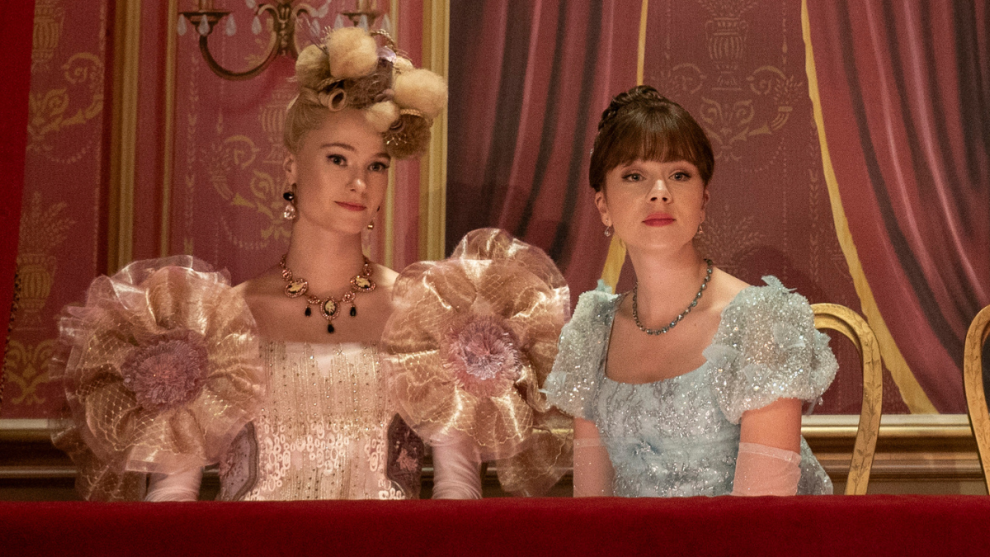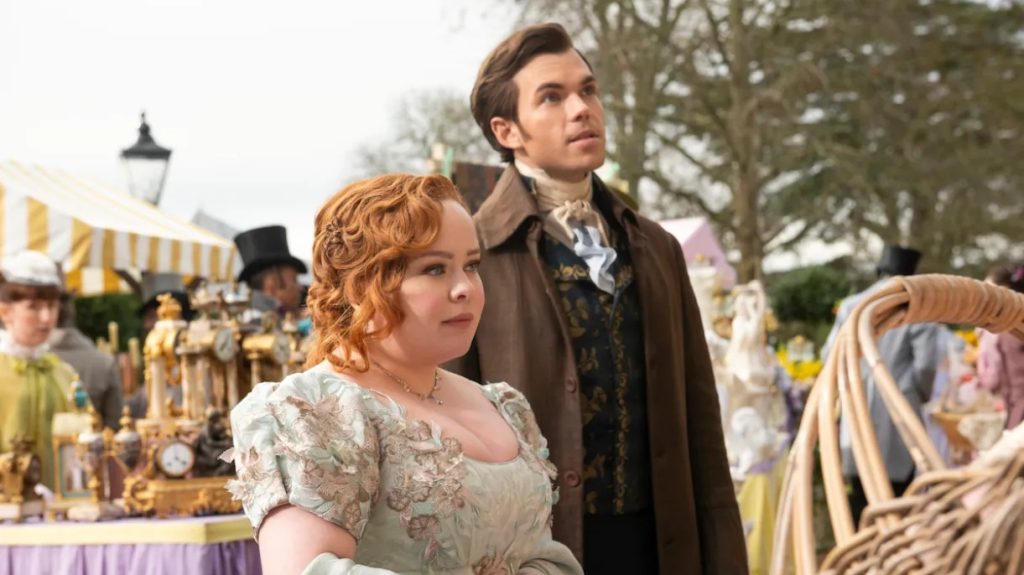Dearest Gentle Reader, the long-anticipated return of Bridgerton has finally arrived, with both parts of the third season now available on Netflix. Following the collective international binge of this much-loved series over the past few weeks, there have been some mixed reviews, and I pose no exception.
★★★★✰
There are spoilers for season three of Bridgerton in this review.
After it was revealed that Colin (Luke Newton) and Penelope (Nichola Coughlan) would be the romantic leads for the third season, the promise of a good old-fashioned friends-to-lovers storyline gave me high expectations, which I am disappointed to say were not quite met. After two seasons of this slow burn romance, fans like myself were ready for Bridgerton’s most exciting season yet. However, the most enticing aspect of this new season has actually been the subplots going on alongside the central romance.
Season three begins in classic Bridgerton style, with the ton arriving back into the city ready for a fresh season of gossip. Only, this time round, there are a few changes. Francesca Bridgerton (now played by actress Hannah Dodd) makes her social debut, assisted by the entire, chaotic Bridgerton household, including Kate (Simone Ashley) and Anthony (Jonathan Bailey) who are still glowing in their newly-wed bliss. We also see Colin Bridgerton return from his travels sporting the now-infamous Bridgerton brother glow-up necessary to take on the role of a romantic lead.
Colin is initially intended to appear as a tall, dark, brooding bachelor. Sadly, what results seems to be something that looks like a cringe-worthy advert for the most painfully masculine aftershave of all time (sorry Luke Newton). Women are seen fawning over Colin, and he spends much of the beginning few episodes flirting with the majority of them by discussing his summer travels. Unfortunately, once again this desired effect of Colin appearing mysterious does not seem perfectly genuine, as he resembles a 19 year-old student trolling continuously about his ‘life-changing’ gap year (that is, before returning to his parents’ 8-bedroom house in Surrey). Luckily the Bridgerton’s notice the strangeness of Colin’s new behaviour, and in true sibling fashion, make fun of him for it—a dynamic I never get tired of seeing on screen.
The only thing more surprising than Colin’s new demeanour was the sudden friendship struck up between Eloise (Claudia Jessie) and Cressida Cowper (Jessica Madsen). After Eloise’s intense dislike towards Cressida for the past two seasons, their friendship seems odd and confusing at first, seemingly a way for Eloise’s to betray Penelope after their falling out last season. Despite this, this female friendship is one of my favourite parts of the entire season. Through her association with Eloise, Cressida becomes a more three-dimensional character, as the audience finally gets to hear her emotional reasoning behind her vicious actions in previous seasons. This friendship also allows us to see character flaws of Eloise, as both Cressida and Penelope express their frustrations with her for her failure to listen to their own issues, both using an extremely similar choice of words, perhaps opening Eloise’s eyes to her tendency of self-absorption.

Something particularly good about this season was the spotlight on the Featheringtons, as they became more than simple comedic relief. Both Phillipa (Harriet Cains) and Prudence (Bessie Carter) now have husbands, which makes for an extremely funny and adorable dynamic. The character development between Penelope and her mother, particularly after her engagement and reveal of being Whistledown, is incredibly written and enjoyable to watch. As well as bringing the Featheringtons a richness of character, Francesca’s debut has made for a central role in this newest season, which made for a very interesting and unique subplot as she navigates high society whilst still remaining a positive on-screen representation for neurodivergent communities.
Colin and Penelope took on the romantic lead mantle this series with a classic friends-to-lovers storyline, where each become jealous seeing one another with other people and even a memorable reaction from Colin when seeing Penelope’s new look. Of course, it wouldn’t be a Bridgerton review without mentioning some of the steamier scenes however. One particular scene after their engagement is said to be the longest sex scene in Bridgerton history, a romantic encounter showing open and honest dialogue surrounding consent—in short, it is exactly how a scene like that would be between two long-time friends. A bit awkward, very vulnerable and very intimate.

Despite this, the development leading up to the pair finally becoming a couple did not reach the standard set by previous seasons. If I’m watching Bridgerton, I’m expecting tension, yearning, moments of sparks between the couple everyone can see but themselves, all leading up to an explosive and romantic declaration. Do the previous declarations “I burn for you” or “you are the bane of my existence” mean nothing to you? While romantic tension has obviously been an aspect of this couple for the past two seasons, I do not believe it was everything it had the hope of being.
Additionally, I thoroughly enjoyed the series’ ability to create on-screen representation that does not feel forced nor plastic. A certain member of the ton is seen to be using BSL in several scenes, in a subtle, yet rather impactful manner. Benedict’s (Luke Thompson) exploration with fluid sexuality coupled rather well with his free spirit, in addition to his feeling of being lost in life as a 20-something man with high familial expectations. Cultural representation is achieved beautifully through styling, such as Queen Charlotte’s protective silks and Kate Bridgerton’s exquisite gowns drawn with both Indian and English regency inspiration. The only controversy representation has caused, has been Francesca’s introduction to Michela in the final episode, following her marriage. While many fans are unhappy that Francesca is seen seemingly having feelings for a woman named Michela (as this character was originally Michael in Francesca’s book When He Was Wicked), I rather enjoyed this small interaction. Francesca mirroring her mother’s description of becoming flustered when meeting her father was a beautiful and subtle act of representation for queer women, and I cannot wait to see how this relationship is explored.

The Verdict
This season, to me, resembles something represented by Love Actually. There are tonnes of stories throughout the ton; they are all authentically complex, all showing the beautiful, the ugly, the heartwarming, the selfish cacophony that makes up the human spirit. These stories are all interlinked in some way, each with love at the centre. Despite the fact that I, alongside many, found Colin and Penelope’s romance to fall slightly short of expectations, this season exquisitely presents an ensemble worthy of much praise, with each subplot not being secondary to the main storyline, reinforcing the overall message taken from season three —“love is not finite”.
Words by Rosie Brennan
Support The Indiependent
We’re trying to raise £200 a month to help cover our operational costs. This includes our ‘Writer of the Month’ awards, where we recognise the amazing work produced by our contributor team. If you’ve enjoyed reading our site, we’d really appreciate it if you could donate to The Indiependent. Whether you can give £1 or £10, you’d be making a huge difference to our small team.
